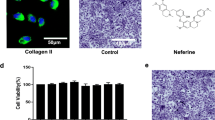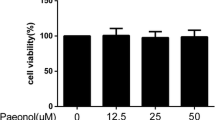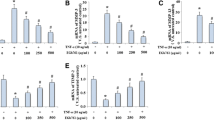Abstract
Objective
The aim of this study was to investigate the effects of andrographolide on matrix metalloproteinases (MMP) 1, 3, and 13 and inducible nitric oxide synthase (iNOS) in human articular chondrocytes from osteoarthritic cartilage.
Methods
Passaged chondrocytes were pretreated with or without andrographolide for 2 h, followed by coincubation with interleukin-1 beta (IL-1β) 1 ng/ml for 24 h. Expression levels of MMP-1, 3, and 13, tissue inhibitor of metalloproteinase-1 (TIMP-1), and iNOS were evaluated using real-time-quantitative polymerase chain reaction, enzyme-linked immunosorbent assay, and Western blotting. Nitric oxide (NO) was analyzed using the Griess reaction assay. Involvement of nuclear factor kappa B (NF-κB) was assessed by Western blotting, transient transfection, and luciferase reporter assay.
Results
Andrographolide tested in these in vitro studies was found be an effective antiarthritic agent, as evidenced by potent inhibition of MMP-1, 3, and 13 and iNOS expression, as well as upregulation of TIMP-1 in IL-1β-stimulated human articular chondrocytes (p < 0.05). The mechanism of andrographolide’s inhibitory effects was mediated by attenuating the activation of NF-κB in human chondrocytes in the presence of IL-1β.
Conclusions
Andrographolide was a potent inhibitor of the production of inflammatory and catabolic mediators by chondrocytes, suggesting that this natural compound may merit consideration as a therapeutic agent for treating and preventing osteoarthritis.






Similar content being viewed by others
Abbreviations
- OA:
-
Osteoarthritis
- IL-1β:
-
Interleukin-1 beta
- MMPs:
-
Matrix metalloproteinases
- TIMP-1:
-
Tissue inhibitor of metalloproteinases-1
- iNOS:
-
Inducible nitric oxide synthase
- NO:
-
Nitric oxide
- NF-κB:
-
Nuclear factor kappa B
- IκB:
-
Inhibitory kappa B
- IKK-β:
-
Inhibitory kappa B kinase beta
References
Goldring MB, Goldring SR. Osteoarthritis. J Cell Physiol. 2007;213:626–34.
Lee R, Kean WF. Obesity and knee osteoarthritis. Inflammopharmacology. 2012.
Loeser RF. Aging and osteoarthritis. Curr Opin Rheumatol. 2011;23:492–6.
Goldring MB, Marcu KB. Cartilage homeostasis in health and rheumatic diseases. Arthr Res Ther 2009;11.
Chevalier X, Conrozier T, Richette P. Desperately looking for the right target in osteoarthritis: the anti-IL-1 strategy. Arthr Res Ther. 2011;13:124.
Dahlberg L, Billinghurst RC, Manner P, Nelson F, Webb G, Ionescu M, et al. Selective enhancement of collagenase-mediated cleavage of resident type II collagen in cultured osteoarthritic cartilage and arrest with a synthetic inhibitor that spares collagenase 1 (matrix metalloproteinase 1). Arthr Rheum. 2000;43:673–82.
Smith GN Jr. The role of collagenolytic matrix metalloproteinases in the loss of articular cartilage in osteoarthritis. Front Biosci. 2006;11:3081–95.
Poole AR. Biochemical/immunochemical biomarkers of osteoarthritis: utility for prediction of incident or progressive osteoarthritis. Rheum Dis Clin North Am. 2003;29:803–18.
Abramson SB. Nitric oxide in inflammation and pain associated with osteoarthritis. Arthr Res Ther. 2008;10(Suppl 2):S2.
Nathan C. Inducible nitric oxide synthase: what difference does it make? J Clin Invest. 1997;100:2417–23.
Amin AR, Abramson SB. The role of nitric oxide in articular cartilage breakdown in osteoarthritis. Curr Opin Rheumatol. 1998;10:263–8.
**e QW, Kashiwabara Y, Nathan C. Role of transcription factor NF-kappa B/Rel in induction of nitric oxide synthase. J Biol Chem. 1994;269:4705–8.
Marcu KB, Otero M, Olivotto E, Borzi RM, Goldring MB. NF-kappaB signaling: multiple angles to target OA. Curr Drug Targets. 2010;11:599–613.
Dai GF, Zhao J, Jiang ZW, Zhu LP, Xu HW, Ma WY, et al. Anti-inflammatory effect of novel andrographolide derivatives through inhibition of NO and PGE(2) production. Int Immunopharmacol 2011; 11(12):2144–2149.
Jiang X, Yu P, Jiang J, Zhang Z, Wang Z, Yang Z, et al. Synthesis and evaluation of antibacterial activities of andrographolide analogues. Eur J Med Chem. 2009;44:2936–43.
Lee YC, Lin HH, Hsu CH, Wang CJ, Chiang TA, Chen JH. Inhibitory effects of andrographolide on migration and invasion in human non-small cell lung cancer A549 cells via down-regulation of PI3 K/Akt signaling pathway. Eur J Pharmacol. 2010;632:23–32.
Shi MD, Lin HH, Chiang TA, Tsai LY, Tsai SM, Lee YC, et al. Andrographolide could inhibit human colorectal carcinoma Lovo cells migration and invasion via down-regulation of MMP-7 expression. Chem Biol Interact. 2009;180:344–52.
Burgos RA, Hancke JL, Bertoglio JC, Aguirre V, Arriagada S, Calvo M, et al. Efficacy of an Andrographis paniculata composition for the relief of rheumatoid arthritis symptoms: a prospective randomized placebo-controlled trial. Clin Rheumatol. 2009;28:931–46.
Altman R, Asch E, Bloch D, Bole G, Borenstein D, Brandt K, et al. Development of criteria for the classification and reporting of osteoarthritis. Classification of osteoarthritis of the knee. Diagnostic and Therapeutic Criteria Committee of the American Rheumatism Association. Arthr Rheum. 1986;29:1039–49.
Altman R, Alarcon G, Appelrouth D, Bloch D, Borenstein D, Brandt K, et al. The American College of Rheumatology criteria for the classification and reporting of osteoarthritis of the hip. Arthr Rheum. 1991;34:505–14.
Lieberthal W, Triaca V, Koh JS, Pagano PJ, Levine JS. Role of superoxide in apoptosis induced by growth factor withdrawal. Am J Physiol. 1998;275:F691–702.
Livak KJ, Schmittgen TD. Analysis of relative gene expression data using real-time quantitative PCR and the 2(-Delta Delta C(T)) Method. Methods. 2001;25:402–8.
Palmieri B, Lodi D, Capone S. Osteoarthritis and degenerative joint disease: local treatment options update. Acta Biomed. 2010;81:94–100.
Malemud CJ. Anticytokine therapy for osteoarthritis: evidence to date. Drugs Aging. 2010;27:95–115.
Aigner T, Sachse A, Gebhard PM, Roach HI. Osteoarthritis: pathobiology-targets and ways for therapeutic intervention. Adv Drug Deliv Rev. 2006;58:128–49.
Nagase H, Woessner JF Jr. Matrix metalloproteinases. J Biol Chem. 1999;274:21491–4.
Brinckerhoff CE, Matrisian LM. Matrix metalloproteinases: a tail of a frog that became a prince. Nat Rev Mol Cell Biol. 2002;3:207–14.
Murphy G, Knauper V, Atkinson S, Butler G, English W, Hutton M, et al. Matrix metalloproteinases in arthritic disease. Arthr Res. 2002;4(Suppl 3):S39–49.
Takaishi H, Kimura T, Dalal S, Okada Y, D’Armiento J. Joint diseases and matrix metalloproteinases: a role for MMP-13. Curr Pharm Biotechnol. 2008;9:47–54.
Pratheeshkumar P, Kuttan G. Andrographolide inhibits human umbilical vein endothelial cell invasion and migration by regulating MMP-2 and MMP-9 during angiogenesis. J Environ Pathol Toxicol Oncol. 2011;30:33–41.
Lee KC, Chang HH, Chung YH, Lee TY. Andrographolide acts as an anti-inflammatory agent in LPS-stimulated RAW264.7 macrophages by inhibiting STAT3-mediated suppression of the NF-kappaB pathway. J Ethnopharmacol. 2011;135:678–84.
Henrotin YE, Bruckner P, Pujol JP. The role of reactive oxygen species in homeostasis and degradation of cartilage. Osteoarthr Cartil. 2003;11:747–55.
Pelletier JP, Jovanovic D, Fernandes JC, Manning P, Connor JR, Currie MG, et al. Reduced progression of experimental osteoarthritis in vivo by selective inhibition of inducible nitric oxide synthase. Arthr Rheum. 1998;41:1275–86.
Nagase H, Kashiwagi M. Aggrecanases and cartilage matrix degradation. Arthr Res Ther. 2003;5:94–103.
Malfait AM, Liu RQ, Ijiri K, Komiya S, Tortorella MD. Inhibition of ADAM-TS4 and ADAM-TS5 prevents aggrecan degradation in osteoarthritic cartilage. J Biol Chem. 2002;277:22201–8.
Vincenti MP, Brinckerhoff CE. Transcriptional regulation of collagenase (MMP-1, MMP-13) genes in arthritis: integration of complex signaling pathways for the recruitment of gene-specific transcription factors. Arthr Res. 2002;4:157–64.
Tian B, Brasier AR. Identification of a nuclear factor kappa B-dependent gene network. Recent Prog Horm Res. 2003;58:95–130.
Hayden MS, Ghosh S. Signaling to NF-kappaB. Genes Dev. 2004;18:2195–224.
Lee WR, Chung CL, Hsiao CJ, Chou YC, Hsueh PJ, Yang PC, et al. Suppression of matrix metalloproteinase-9 expression by andrographolide in human monocytic THP-1 cells via inhibition of NF-kappaB activation. Phytomedicine 2012.
Acknowledgments
This study was supported by a grant from the Natural Science Foundation of China (30901531), Natural Science Grants of Zhejiang Province (Y207216) and National Natural Science Foundation of China (81071492).
Conflict of interest
None.
Author information
Authors and Affiliations
Corresponding author
Electronic supplementary material
Below is the link to the electronic supplementary material.
10165_2012_807_MOESM1_ESM.tif
Effects of andrographolide on interleukin (IL)-1β-induced COL2A1, COL9A1, ACAN, ADAMTS-4, 5, and TIMP-3 gene expression. Chondrocytes were pretreated with various andrographolide concentrations for 2 h, followed by stimulation with IL-1β (1 ng/ml) for 24 h. Relative gene expressions were determined by real-time quantitative PCR. Data are expressed as mean ± standard deviatiion (SD). *p < 0.05 andrographolide treated chondrocytes compared with chondrocytes stimulated with IL-1β alone. (TIFF 222 kb)
About this article
Cite this article
Ding, Qh., Ji, Xw., Cheng, Y. et al. Inhibition of matrix metalloproteinases and inducible nitric oxide synthase by andrographolide in human osteoarthritic chondrocytes. Mod Rheumatol 23, 1124–1132 (2013). https://doi.org/10.1007/s10165-012-0807-6
Received:
Accepted:
Published:
Issue Date:
DOI: https://doi.org/10.1007/s10165-012-0807-6




